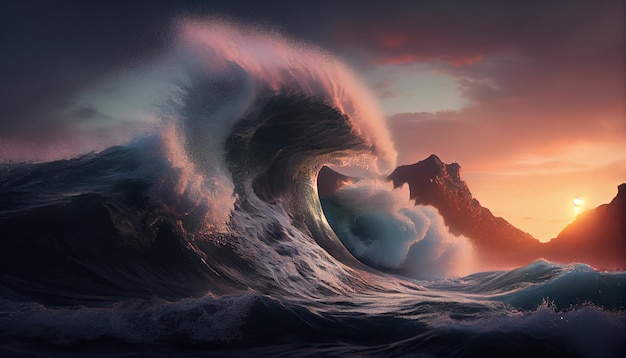

Tsunamis are giant ocean waves usually caused by earthquakes or volcanic eruptions.
The word tsunami comes from the Japanese words tsu (meaning harbor) and nami (meaning wave).
Tsunamis can travel at speeds over 500 miles per hour.
The largest recorded tsunami occurred in 1958 in Lituya Bay, Alaska, with a wave height of 1,720 feet.
Tsunamis can travel across entire ocean basins, affecting coastlines thousands of miles away from the source.
Unlike normal ocean waves, tsunamis are characterized by long wavelengths and periods.
Tsunamis can be generated by undersea landslides, and even asteroid impacts.
Indonesia is the country most affected by tsunamis, due to its location along the Ring of Fire.
Tsunamis can also be created by underwater volcanic eruptions, which can produce local tsunami waves.
The Indian Ocean earthquake in 2004 triggered a mega-tsunami that killed over 230,000 people in 14 countries.
Tsunamis can generate multiple waves, with consecutive waves often being the largest.
During a tsunami warning, people are advised to move to higher ground and stay away from the coast.
Tsunamis can cause significant damage to coastal infrastructure, erode beaches, and destroy ecosystems.
Tsunamis are not always visible from the shoreline, as waves can often appear as a rapid, outgoing tide.
Tsunamis can travel across the open ocean without being detected until they reach the coastline.
The Pacific Tsunami Warning Center is responsible for monitoring tsunamis in the Pacific Ocean.
Early warning systems are crucial in minimizing the impact of tsunamis on coastal communities.
Tsunamis can cause strong currents and turbulent waters, making it dangerous to navigate near the coast.
Tsunamis can devastate marine life, causing fish and marine mammals to become disoriented or stranded.
The height and intensity of a tsunami can vary based on factors such as the magnitude of the earthquake or the shape of the coastline.
Tsunamis can cause extensive damage to ports and harbor facilities, disrupting global trade.
The Indian Ocean tsunami in 2004 was one of the deadliest natural disasters in recorded history.
Tsunamis can impact shallow coastal areas more severely than deeper offshore locations.
The energy released by a tsunami can be equivalent to multiple atomic bombs.
Tsunamis can generate significant economic losses for affected regions, requiring lengthy recovery and reconstruction efforts.
Animal behavior has been observed to change before the arrival of a tsunami, as they sense the approaching wave.
Tsunamis can cause saltwater intrusion, contaminating freshwater sources and affecting agriculture.
Tsunamis can travel up rivers and estuaries, affecting inland areas that may not be directly connected to the coast.
Tsunamis can generate strong whirlpools and eddies, adding to the chaos and destruction in affected areas.
In some cases, tsunamis can lead to the formation of new islands or alter the shape of existing ones.
Tsunamis can cause long-lasting psychological trauma, particularly for survivors who have lost loved ones or witnessed the destruction firsthand.
Early tsunami detection systems use sensors placed on the ocean floor to detect changes in water pressure and elevation.
Subduction zones, where one tectonic plate slides beneath another, are common areas for tsunami generation.
Tsunamis can travel across different ocean basins, affecting both the Pacific and Atlantic coasts.
Tsunamis are not limited to coastal areas, as they can travel up rivers, reaching inland communities.
The Tohoku earthquake and tsunami in 2011 severely damaged the Fukushima Daiichi Nuclear Power Plant, causing a major nuclear accident.
Tsunamis are less likely to occur in the Atlantic Ocean compared to the Pacific Ocean due to differences in tectonic activity.
Tsunamis can cause significant erosion, with entire sections of coastline being reshaped or destroyed.
Tsunami survivors often face a lack of basic necessities, such as clean water, food, and shelter, in the aftermath of a disaster.
Tsunamis can generate powerful surges, pushing debris and vehicles inland with devastating force.
Tsunami evacuation routes are designated in at-risk coastal areas to guide people to safety during an emergency.
Tsunamis can travel across the open ocean for several hours before reaching land, allowing for some warning time.
Tsunamis can cause extensive damage to coral reefs, disrupting fragile ecosystems that take years to recover.
Communities vulnerable to tsunamis often conduct regular drills and education programs to ensure residents are prepared for a potential disaster.
Tsunamis serve as a reminder of the power and unpredictability of nature, highlighting the importance of disaster preparedness and resilience.
Around the world, coffee enthusiasts enjoy Monin coffee concentrate since it is a multipurpose product. Conveniently combining…
The Importance of Choosing the Right Shower for Your Bathroom Renovating your bathroom can be…
Usain Bolt holds the record for the fastest 100-meter sprint in history.Bolt was named Sportsman…
Love is in the air... and it smells suspiciously like chocolate!Roses are red, violets are…
Life's a beach, take a picture and relax.Sun, sand, and salty kisses. That's what beach…
Hungary is home to the largest thermal water cave system in the world.The Rubik's Cube…